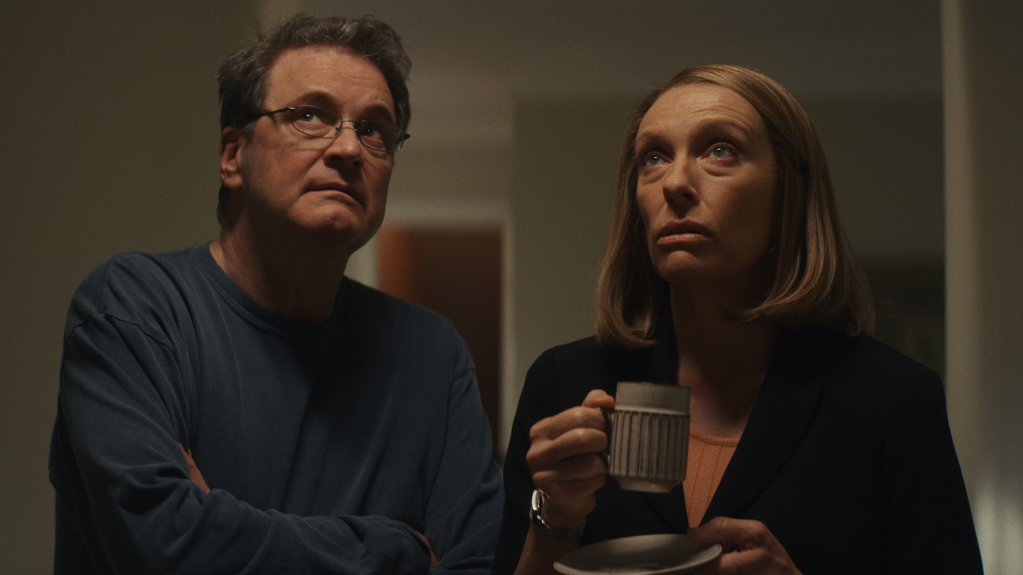As the production designer of “The Staircase,” HBO Max’s adaptation of the seminal true-crime docuseries, Michael Shaw had immense challenges in front of him, chief among them the series’ namesake.
The show, which premiered May 5, explores the confounding circumstances of the death of Kathleen Peterson (played by Toni Collette), whose body was found at the bottom of a narrow staircase in the back of the North Carolina home she shared with her novelist husband Michael (Colin Firth) and their five children. Although the original French documentary series captures the Peterson family and their house in great detail, when Shaw first signed on alongside set decorator Edward McLoughlin, he hadn’t seen the documentary — and didn’t plan to.
“I wanted to read the episodes and interpret it as if it wasn’t a real event,” Shaw said. “It was important to create something that wasn’t a replica of the doc.”
Eagle-eyed fans of the original series will notice deviations in the new settings, but the home’s back and front staircases required such heightened attention to detail that Shaw eventually had to view the source material.
“Those two elements symbolize what the whole story is about,” Shaw said. “The grand staircase is the facade that you put on to the public, and the back staircase is where all the secrets are kept.”
The HBO Max series depicts the many ways Kathleen could have died, and the production team built three versions of the stairs: covered in blood, as it appears in crime scene photos; pristine, as it existed before Kathleen’s death; and covered in padding and green-screen fabric, for VFX and stunts.
Showrunner Maggie Cohn said that while the show was in production, the real Peterson home at 1810 Cedar just happened to be up for sale — a “pure coincidence” that allowed the team to build those three stairways as precisely as possible.
“We were able to get into the house with our location manager and part of our art department and measure it exactly,” Cohn said. “These three staircases were the only things that were identical to the ones in the house. I cannot tell you how difficult it was to make them identical, because when you are striving to replicate something explicitly and literally, it is nearly impossible.”
However, more complicated than the staircase itself are the gruesome blood spatters that adorn it, the patterns and placement of which play an integral role in the legal case. Experts re-created scenarios for how a woman falling down the stairs (or being bludgeoned at the bottom of them) could lead to such a horrific display, and Shaw said his team took “great pains” to replicate it.
“Doing that with paint is incredibly hard,” Shaw explained. “Our amazing [on-set scenic artist Tammie Trimble] became kind of a blood-splatter shaman. We gave her the set, and she closed herself off for about five days and would look at pictures of Kathleen and play whatever music moved her. Nobody could go in there all day long. [Tammie] went beyond to find this place where she wasn’t really just painting; she was channeling something.”
Cohn added that the creative team wanted to “demystify the staircase,” allowing viewers to see that it’s just a set of stairs like any other. The series plays with viewers’ expectations of that part of the house, even showing Kathleen’s daughter tripping as she climbs it in the pilot episode.
“The staircase is something that’s just part of everyone’s home,” Cohn said. “We wanted to make it part of the discourse by taking some of the prejudice away from it. But then of course, this is the location where Kathleen passed away. So you always know it’s going to happen, you just don’t know quite when.”
In addition to the staircase, Shaw and McLoughlin were tasked with creating a world that isn’t seen in the doc, which doesn’t linger too long on the minutiae of the Peterson home. McLoughlin specifically paid attention to the objects and decorations that would communicate Collette’s character, who is both at the center of the original series and completely absent from it. The key elements on that front were Kathleen’s bedroom and kitchen, her penchant for Christmas decorations and her office at Canadian communications company Nortel Networks.
“There were things from the house that we incorporated into her office,” McLoughlin said. “We showed that she traveled to Japan and had those kinds of influences there, but just very lightly.”
As a whole, Shaw said he was inspired by the role of the Dakota apartments in Roman Polanski’s 1968 film “Rosemary’s Baby.” From Michael’s office, filled with “a cacophony of weird stuff he collected,” to the dining room — which McLoughlin said starts off “as a centerpiece of the family” before becoming a “war room” during the legal battle — the house functions as its own character in the series. The home’s exterior was scouted in Atlanta, and from there, Shaw said he focused on balancing the realistic and artistic interpretations of what goes on inside.
“The doc is very tight and you don’t really get a sense of the flow of the house,” he said. “But in our show, you do. You see every nook and cranny.”
Jenny Maas contributed to this report.
From Variety US





































